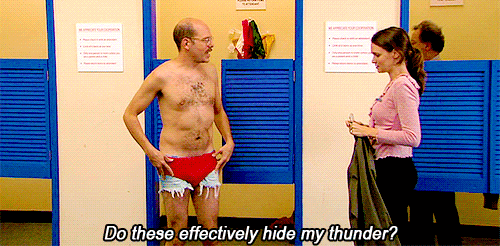At the request of a reader who read The Short Game, I've compiled a list of tips for the Husky Gentleman. Admittedly, I had to look up what 'husky' meant; embarrassing, I know. What can I say? Urban Dictionary has been a godsend.
Anyways, hope these tips will help out a few gentlemen out there. Please note that these strategies are not just for the husky gentleman, but could also be used for the tall or large-framed man.
Focus on the fit. A lot.
Regardless of the colour, style or fabric, the fit of a suit will always be the most important factor. For the husky gentleman, it's often natural to pick out a suit that is bigger than your frame, mostly because it's better than going with a suit that's too tight. And, it gives you breathing room in case you put on a few extra pounds later. Nonetheless, try to find a suit that drapes naturally over your body; there shouldn't be any significant creases, bulging or air pockets. Always try to find a suit that has clean lines around your shoulders (i.e. virtually no air pockets) and chest (the suit lapels should drape downwards without disturbance).
Stick to solid coloured suits.
Patterned and textured suits can look really nice on a man, but may be overwhelming, especially if you are on the husky side. For example, a window pane suit (pictured below) looks fashionable and trendy, but the square pattern aims to make the wearer appear wider and bigger. This effect is likely the opposite of what a husky gentleman would want.
Therefore, it would be safer to go with a solid suit. But do not confused 'safe' with 'boring'; there is nothing boring about a safe suit, especially if it complements the wearer's body frame. If you'd like to add some pattern, wear a patterned tie and/or pocket square to add a little extra texture.
Go with a wider lapel and tie.
The general rule of thumb is to have the tie width be the same as the suit jacket lapel. That way, the ensemble looks balanced and proportionate.
For those who have broad shoulders, going with wider suit jacket lapels and ties can add additional balance to your look. A standard lapel/tie will usually be around 2.5~3.0 inches; therefore, you could try going with a 3.5~4.0 inch lapel/tie combination instead to cover more real estate across your chest and make your look even more proportionate.
Cater to your face.
What?
While not crucial, picking out a particular shirt collar to go with the shape of your face can make a difference when putting your look together. For those with round faces, a forward point collar is the most complementary since the collar is longer and downward pointing, making the wearer appear thinner. Conversely, those with angular shaped faces could choose to wear semi or full spread collars.
Wear straight cut pants.
 |
| L to R: Slim, Fitted, Straight, Loose |
Finally, going with straight cut pants is recommended for the husky gentleman. Slim fit or extreme tapering may be very uncomfortable for larger individuals (especially in the thigh area) and the appearance may not be flattering. If the wearer really tapers his pants (i.e. small ankle openings), it will make him look extremely top heavy, especially if his mid-section and chest are broad. The imbalance will be reminiscent of the guys who skip leg day at the gym.
 |
| "There is no such thing as leg day," said this champion. |
At the end, it really comes down to fit. You can play with all the colours, fabrics and styles all you want, but the fit will really determine whether you look put together or not. If you do generally wear suits that are too big, try going down a size; the end result is cleaner lines, less bulging and a better look. I'm not saying that you should go out and wear the smallest suit you can fit into, but it might be worth trying on a jacket that's just a touch closer to your skin. It never hurts to try out a fitted jacket.
It also never hurts to exercise your legs.













